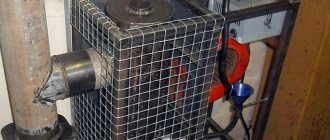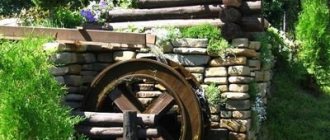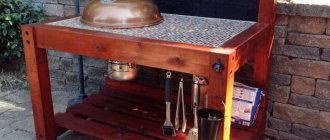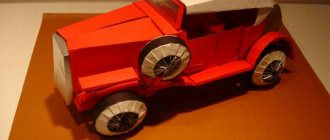A potbelly stove is a compact iron stove with a chimney at the top. It consists of a chamber into which solid fuel is poured, a grate in the form of a metal grate, a pipe - a chimney and an ash pan for collecting ash.
If you know how to handle a welding machine, the device is easy to manufacture, and at the same time, it will serve faithfully in an unheated room, in field conditions, in the absence of centralized heating for decades.
How to do it yourself?
Manufacturing options:
Rectangular oven
It is a metal box; you can independently weld the structure from steel sheets. For a rectangular potbelly stove, an old car tank or box will do just fine.
Typically, this form is chosen when it is necessary to cook food on the stove.
On the spacious platform you can place 2 large pans or containers for heating water at once.
The manufacturing principle is simple: doors are built to cover the ashpit and combustion chamber, a hole is made for the chimney, combustion products must leave the room in a timely manner, otherwise you can inhale carbon monoxide.
From a gas cylinder
The most common type of potbelly stove. The cylinders have thick walls, making the stove durable, mobile, and fireproof.
First, a drawing is drawn and markings are made. The combustion chamber door will be located in the center of the cylinder. The blower is in the same plane, only 10–12 cm lower.
Instructions:
- We take a grinder , cut out both doors, and draw a closed line between them.
- We cut the cylinder into 2 parts along the line
- at the bottom - a vent.
- We install the grille and weld both parts again.
- For the valve we make a hole with a radius of 10 cm.
- To extract , we insert a hole into the pipe and weld the objects together by welding.
- A simple stove from a cylinder is ready, you can use it, add fuel and check its operation.
For cooking on the top of the stove, the design is slightly different:
- is cut off .
- Rods are inserted and welded inside
- A hole for the pipe is cut out at the top side You can heat and cook food at the same time.
- The hole is welded , the valve is screwed in, and a comfortable handle is adjusted.
- You can also make a stove from a pipe The barrel or pipe must be selected according to its diameter.
- At the bottom of the pipe barrel , cut 2 holes for the firebox and ash pan.
- Make the doors.
- Frame holes with metal strips.
- Under the combustion door, at a distance of 10 - 12 cm inside the barrel, weld brackets in the corners, the grate will rest on them, pre-weld it from any fittings.
When making a stove from a pipe, weld the bottom, as well as the part on top:
- Weld 4 legs to the bottom
- on the surface , weld a pipe to it, this will be a chimney.
- Weld the hinges to the previously cut holes and install the doors. Also, mark and attach a hook so that the doors lock tightly.
- For the aesthetics of the structure, treat all welding seams, clean them 10. Paint the outside of the device with heat-resistant paint. Whatever the factory product, you can sell it or successfully use it yourself.
Working furnace
The option is distinguished by a specific odor that oil waste will emit during fuel combustion, even in the presence of an exhaust hood.
Instructions:
- To make this model , select sheet material with a thickness of at least 4 mm, a chimney pipe, and individual small structural elements.
- Make precise markings of all elements on the sheet, having previously drawn a drawing.
- Cut all the elements with a grinder and clean the edges of the parts. Drill round holes in the pipe.
- At the top of the tank , cut a hole for the pipe, offset from the center to the left.
- Offset to the right on the circle, drill a hole for the connecting pipe.
- You get 2 circles , weld them to the pipe; the thickness of the upper tank will depend on its length.
- Similarly, decorate the part of the stove from below , but now cut a hole right in the center of the marked circle.
- Cut a second hole nearby and attach the sliding cover to it.
- Weld 4 legs to the bottom plane.
- Clean the seams after welding , paint the surface with paint that is resistant to high temperatures.
- Connect the chimney to the stove. The waste will be poured into the lower part of the tank; after the paper is ignited, the sliding lid closes and the waste begins to burn. Oxygen will penetrate through the holes, and the waste will burn intensely.
Design features and principle of operation
Like any other direct combustion solid fuel stove, the unit, made from a gas cylinder, consists of several parts:
- firebox combined with the body;
- grate;
- blower chamber;
- chimney.
The blower is located at the bottom of the stove and is a small chamber (essentially a channel) necessary to supply oxygen to the combustion zone. To regulate the amount of air, monitor the process and remove ashes, the ash pan is equipped with a door.
Simple design is one of the components of the success of cylindrical potbelly stoves
In the middle part of the furnace there is a combustion chamber, which is separated from the ash pan by a grate. Being the main module of the heating device, the firebox simultaneously plays the role of a loading compartment and a heat exchanger. Like the vent, the firebox is equipped with a door through which firewood is placed into the potbelly stove and ash is removed.
The chimney is a channel necessary to remove combustion products from the working area. A damper must be installed in the chimney, which is closed after the wood burns out. This prevents heat from escaping from the room when the stove is not in use.
The operation of a heat generator from a gas cylinder is not difficult. After the firewood is placed on the grate, they are set on fire and the combustion chamber door is closed. The blower must be open at this time - air passes through it to the fuel. The intensity of combustion is controlled by closing or opening the bottom door. Heated gases are removed through the chimney.
To increase the efficiency of heat exchange, the potbelly stove is equipped with additional elements that allow the residual heat of the flue gases to be removed. To do this, an air heat exchanger or a water jacket is installed on the chimney. Often the modification consists of lengthening the part of the chimney that is located in the room.
Necessary materials, tools
Before starting work, prepare the tools:
- metal brush;
- chisel, pliers, hammer;
- tape measure, chalk;
- drill with metal drills;
- sander;
- metal circles;
- welding machine;
- protective mask;
For the body you will need a pipe 30 cm in diameter, at least 5 mm thick. You can use sheet metal of the same thickness instead of a pipe.
For the chimney, you should select a pipe 12 cm in diameter, with a thickness of at least 3 - 4 mm. To prevent burnout, a metal box is suitable for the ash pan, so you need to choose durable sheet metal.
What kind of stoves can be made for a garage
It is very unpleasant to be in a cold garage in winter. That's why heating is required. Garage stoves are usually small steel stoves such as potbelly stoves. They are made from thick-walled barrels, pipe sections or gas cylinders. Such garage stoves are simpler to make and require only minor modifications, since the body, and sometimes the bottom, is already there. Furnaces are also made from sheet metal, but these are options for those who are closely familiar with welding. Brick stoves are not very common in garages - they are still larger in size and heat up less, which is not entirely suitable for this case.
One of the garage ovens
The most common stoves are those that burn wood; everything that burns is stored in them. Such omnivorousness and fast heating are their main advantages. They also have many disadvantages, and one of them is gluttony, which is why recently they have begun to make more economical long-burning stoves. Typically the top combustion principle is used. They are good because one full load (a stove made from a 50-liter propane cylinder) can burn for up to 8 hours. All this time it is warm in the garage.
The stoves undergoing testing are special. There is plenty of such fuel in garages, but you have to be careful with the waste - it contains heavy metals and excellent traction is required to prevent them from getting inside.
Step by step guide
First you need to cut the metal, taking into account the thickness and length of the required blanks.
Remove the chamfers from the parts, touching the stove will be safer, and the welding seams will be stronger:
- Check that the parts are correctly marked before you start cutting them. When cutting, take into account the thickness of the oven walls, as well as the thickness of the circle.
- Remove the chamfers from the prepared parts for safety from accidental contact with a hot device.
- Check all part markings.
The structure is installed in the following sequence:
- Connect the welding machine to the network.
- Take an electrode with a thickness of 4 - 5 mm, taking into account the sheet or pipe.
- Set the current on the device to 160 A.
- Wear special glasses and protective clothing, and protect your hands with gloves.
- Weld three walls to the bottom of the oven
- the bottom of the device at least 5 cm from the floor.
- Connect the parts at right angles. Check their perpendicularity with a level.
- Where necessary , straighten the corners of the parts.
- Weld the parts and joints relative to the floor level, at an angle of 45 degrees.
- Weld a partition between the ash pit and the firebox, first cutting holes to prevent ash from accumulating.
- Maintain a distance between the holes of at least 5 cm from the walls of the stove. The distance between the partition and the bottom of the structure must remain at least 10 cm.
- Lastly, by welding, cut holes for installing the chimney on the back panel of the homemade stove.
- Make markings , drill rectangular holes in the places intended for the firebox and vent.
- Align all the bottom parts of the holes with the partition. The distance between the walls of the firebox and the upper side edges should be at least 3 - 5 cm. The opening for the vent is slightly smaller, but not more than 5 cm.
- Use a grinder to cut two holes out of metal and form doors. Weld them onto the canopies, raise the blower as much as possible to the top of the slab opening so that they do not sag in the future under the influence of high temperatures.
- to the doors ; they should open and close easily, without obstacles.
Direct assembly
During the welding process, special attention should be paid to the quality of the weld, since it is necessary to make a container completely sealed at the joints in order to prevent fuel leakage. The container is made by cutting a strip, which is folded into an even circle and welded, and cutting out two circles to serve as the bottom and lid
In this case, two holes are required in the lid. The first is for the diameter of the pipe, the second is for filling oil and for air flow.
Each part is manufactured separately. Final assembly occurs at the final stage
The second container is made in the same way, with the only difference that a rectangular piece of metal with a length slightly less than the diameter should be welded inside it, which will serve as a partition between the chamber itself and the chimney pipe. In the second container, a hole should be made in the bottom for the connecting chamber pipe, and a hole for the chimney pipe should be made in the lid.
During the installation process, you should be guided by the proverb “measure twice, cut once” so as not to go out of size.
After making both chambers, you should take care of the burner pipe, in which you need to drill a certain number of holes, it should be borne in mind that the more there are, the stronger the air flow will be, and the more active the combustion process will occur, but there will be too few holes will not create the required thrust.
A number of holes should be made in the pipe leading to the upper tier and then welded to other elements
The last, final stage will be the final assembly of all parts into a single structure with the obligatory careful welding of all seams, maintaining complete tightness. The only part left removable is the top chamber cover. Lastly, the chimney pipe is installed, which is not recommended to be installed in a horizontal plane; it is best to use a small angle, and for greater rigidity and structural strength, connect the pipes to the lower fuel tank using steel reinforcement or rods.
Most often, a potbelly stove operating in mining is installed on legs, which are made of short metal corners welded to the bottom.
The supporting elements of the entire oven are a metal corner welded to the lower “pan”
The process of making a stove based on an old potbelly stove is practically no different. The only thing is that the fuel tank is installed in the combustion chamber of the stove, and all the dampers, ash pans and the combustion door are welded. When installing a furnace in a potbelly stove, the most convenient way to add oil is to remove the fuel tank from the furnace firebox.
This material will be perfectly complemented by the following publications:
- Features of using a wood-burning stove in the country
- Do-it-yourself long-burning potbelly stove: step-by-step instructions
How to make a long-burning potbelly stove?
To ensure that the potbelly stove radiates heat for as long as possible without adding another portion of firewood and does not burn out quickly, you can make a long-burning stove, the fuel will not burn, but will smolder, the heating process without adding firewood can be extended for several hours.
Making a stove for long burning is somewhat different from the usual design.
The best cylinder for the stove is:
- Cut off the top of it , this will be the lid of the stove.
- Make a hole at the top and side of the stove, this will be the hood.
- Make a hole in the center so that you can easily insert the balloon.
- Weld a pipe to the cut hole of the pancake, slightly longer than the cylinder. The pipe will serve as a blower, and oxygen will flow into the furnace, and the fuel will not smolder and not burn.
- Cut off part of the cylinder in the center, insert a pipe into the hole as a blower. The operating principle of a long-burning potbelly stove is to create pressure inside the chamber. After the firewood ignites, a heavy metal circle plunges inside and begins to put pressure on the fuel, creating pressure on it, the fuel begins to lack oxygen and slowly smolder. The smoke, going upward, comes out through the chimney, the room will not be smoky.
Selection and preparation of the cylinder
The first thing you need to decide is the size of the metal container. The size is chosen based on the area of the room in which the cylinder stove is supposed to be installed. You can choose from the following options:
- 5 l cylinder. A five-liter container can heat a small room. Little fuel fits into it, and only in the form of chips or briquettes.
- For 12 l. The furnace will be able to provide small (up to 3 kW) thermal power. The heat is enough to warm a small workshop, utility room or gatehouse.
- For 27-30 l. You will receive up to 7 kW, which will be enough to heat a garage, garden house or greenhouse.
- For 40 l. Industrial cylinders have a small diameter and thick walls, therefore, the fuel load will be small. It is better to shorten such a container and make a small stove that will hold heat longer and last longer.
Potbelly stove with heater for a bath Source s-proms.ru
See also: Catalog of companies that specialize in the design and installation of fireplaces and stoves
- For 50 l. A propane cylinder is considered the best option for making a potbelly stove; Such dimensions are capable of providing heat to the cottage.
The cylinder needs preparation: removal of gas residues. If cleaning is neglected, an explosion may occur when cutting metal. The cylinder will become safe after the following measures:
- Unscrew the valve to get rid of any remaining gas. You need to set aside a day, so the container is left to vent the gas in the open air or in a non-residential area with good ventilation.
- Then the container is turned over to drain the condensate (any unnecessary container with a lid will do - condensation has a pungent odor).
- At the end, the container is filled with water to the very top for several hours to displace residual vapors. After draining the water, the cylinder can be cut without danger.
Advantages and disadvantages
Like any other heating device, the stove has both pros and cons.
The undoubted advantages of a homemade stove are:
- Compact size.
- Use of any available fuel , you can burn peat, firewood, sawdust, wood chips, coal.
- Insignificant costs for manufacturing the device ; basically, you can get by with available materials.
- Installation of the structure does not require laying a foundation or a chimney.
The disadvantages of the stove include:
- Quite a large consumption of fuel material, the principle is this: while you heat it, it’s warm. To keep the room from cooling down, you need to add fuel more often, otherwise you may simply freeze.
- The walls of the oven become very hot; contact can cause burns.
- Do not allow coals to fall out of the stove, as this may cause a fire.
About the temperature in the garage
In such a room it is not easy to equip a traditional heating system, and all this will be quite expensive. On the other hand, the optimal air temperature must be maintained in the garage, because it is not recommended to store the car at temperatures less than +5 degrees , while a minimum of +18 degrees .
Typically, compact, economical stoves with fairly high efficiency and good heating of the room are used to heat garages. It is also important that the stove warms up the garage quickly and is safe at the same time. It’s a big plus if the fuel can be various types of waste – wood, for example, or recycled motor oil. This will make heating your garage even cheaper.
Note! Portable electric heaters for garages are almost never used because they are ineffective. They are also unsafe and should not be left unattended. And no one wants to spend the night in the garage to look after all this.
Garages are rarely well insulated using high-quality thermal insulation materials, and therefore heat loss in such rooms is usually high. In addition, to heat a small area, sometimes much more energy is needed than to heat a house. On average, a heating device with a power of 2.5 kW is enough to heat a garage with a standard area. To maintain a constant temperature of about +16 degrees, you will need a 2 kW oven. Quite often, owners, trying to save money, do not heat the entire garage, but only the area where they work.
On a note! If you properly insulate gates and walls, as well as seal all cracks, you can reduce heat loss and thus save money, since it will be easier to maintain the required temperature.
Installation safety rules
Any homemade heating device is designed to heat the room, making it more comfortable, but at the same time, such devices are far from safe and are fraught with ignition and fire.
When installing the structure, it is very important to follow safety rules:
- The stove must be installed on a surface that is resistant to fire, otherwise the floor may burn out. To do this, it is good to lay bricks and tiles on the floor.
- The walls of the stove should not overheat too much; for this purpose, special plasterboard or other non-flammable material is used in production.
- Highly flammable materials should not be placed near the firebox; they may catch fire.
- Take care of ventilation in the room where the potbelly stove will be located. Carbon monoxide must escape outside in a timely manner and not accumulate inside the room.
- only high-quality, fire-resistant material in production
A small country house, garage or workshop can be heated using a small compact metal stove called a potbelly stove. It can be made either from an old steel pipe, a gas cylinder, a barrel, or even an old flask, or welded from sheets of metal. The most important thing is that the metal used to make such a furnace is not too thin.
Potbelly stove made from a gas cylinder, an old flask, a barrel and a stove running on waste fuel
Making a pallet for mining
The tray was made from a cast iron automobile brake disc. Cast iron has good heat resistance, so I decided to use it.
I will make a pallet from this disk
I welded the bottom underneath.
The steel circle is the bottom
Welded the bottom
I welded the lid on top. In it you can see the counterpart of the burner and the opening. Air enters the stove through the opening. I made it wide - it's better that way. With a narrow opening, the air draft may not be strong enough, which is why the oil will not be able to get into the pan.
Next I made a coupling. In my stove it connects the pan and the burner. With a coupling it will be much easier to maintain the stove. If necessary, I can take out the tray and clean the burner from below.
Next I made a couplingCoupling
I put the clutch in place
I put the clutch in place
The coupling was made from a 10-centimeter pipe, simply cutting it along the longitudinal edge. I did not weld the opening in the coupling - there is no need for this.
Materials and tools
To create a potbelly stove you will need: • metal with a thickness of 3±0.5 mm: thinner sheets will quickly burn out, in addition, under the influence of high temperature they can warp, and the stove will become shapeless; thick-walled metal will take a very long time to warm up; • chimney pipe; • rods 16 mm; • a sheet of metal with a thickness of 0.3 mm for constructing a box for collecting ash; • tape measure, ruler, chalk; • welding machine 140-200A; • grinder for cutting metal; to make round holes it is more convenient to use a gas cutter; • metal brush for cleaning welding areas; • emery wheel for adjusting doors; • drill and drill bits.
Instructions
At a certain point in construction, the question arises of how to properly construct a potbelly stove yourself. A 200 liter barrel just becomes one of the most suitable frames. The stove can be distinguished by shapes and sizes; it can be round, square, located horizontally or vertically. It all depends on your imagination and the room.
Vertical model
Vertical stoves are manufactured in the following sequence:
- Preparing an opening on the side of the barrel to make it possible to load fuel.
- You can purchase the door in advance or try to replace it with a cut-out part from the wall of the container - welding a handle and hinges to it for ease of opening and closing the firebox.
- Just below the door, cut an additional hole to install the blower door. To create a blower, a thick-walled pipe is used, which could move along metal slats, but not be completely pulled out.
- Grate bars are mounted 20 cm above the bottom of the barrel - this is a metal plate with holes; it can be replaced with a cellular part made of reinforcement. Fixation is carried out using a steel angle.
- Metal legs are welded at the bottom of the barrel, or the structure is simply installed on bricks.
- The role of the cooking panel is performed by steel wire; it is welded to the top lid of the oven.
- To protect the walls from burning inside, the firebox can be lined with refractory bricks, giving it the shape of a semicircle using a grinder. The masonry is done with a special oven mortar, which contains part fatty clay and two parts sand. This mixture is diluted with the minimum possible volume of water, it should turn out very thick.
- Then the chimney is formed. The hole for the pipe is at least 15 cm in diameter, usually made on the side or top of the barrel. The height of the pipe is more than 4 m. To reduce the load on the body, the chimney should also be secured to the wall.
- You can make a rotary or moving valve on the chimney. It will help to quickly adjust the removal of heated smoke, completely blocking the chimney when the stove is not working.
Vertical oven
Horizontal model
From a barrel with a volume of 200 ml you can also make a device for heating a room, which would have a horizontal location
First, it is important to prepare the structure to support the frame. The height is calculated taking into account the operating characteristics
When choosing this indicator, you should first pay attention to the area of the room where you plan to install a homemade potbelly stove
The drawing always takes into account the specific placement of the furnace. The assembly of a horizontal unit is carried out almost identically to a vertical one. In more detail, the process includes the following steps:
It is necessary to form a hole in the bottom of the prepared barrel, which will be used to remove ash
It is important to understand that its size should not be too large. Now you need to build an ash pit. Its dimensions should not be more than a third of the height of the canister
The height of a 200 liter barrel is 85 cm - the calculation is based on this parameter. The material you need to choose is a regular sheet of metal that would be suitable in thickness. It is connected to the bottom of the heating device. Welding equipment is used for this. To arrange the ash pan, it is necessary to provide another viewing window; the compartment must be cleaned through it. Then the installation of the chimney structure is carried out. The two most popular pipe locations are on the back wall or on top.
Horizontal ovenA long-burning potbelly stove, which is placed horizontally, can be used not only for heating garages, basements, and various buildings, but also for cooking and heating food. For this purpose, it is supplemented with an arched panel. The device turns out to be mobile, so you can even take it with you into nature.
Schemes of potbelly stoves
The main advantage of a rectangular stove
, unlike oval products made from pipes or gas cylinders, lies in a larger heated surface area, so its efficiency will be much greater. The optimal size for a potbelly stove is 800x450x450 mm. A stove of this size will not take up much space and will easily fit even in a small room.
An important difference between the Loginov stove
is the presence of two plates (
reflectors
) in the upper part of the combustion chamber.
Since the path of gas movement
increases, the heat transfer of such a potbelly stove is significantly higher than that of a conventional metal stove.
Advice
. If you need to reduce the size of the Loginov oven, then it is advisable to change only its width. If the length and height of the structure changes, its efficiency may decrease significantly.
Detailed diagram of Loginov's potbelly stove
Case manufacturing
I will make a stove from this cylinder.
I used a used cylinder. There was no more gas in it, but just in case, I opened the valve and left the cylinder outside overnight.
Then I carefully and slowly drilled a hole into the bottom of the cylinder. To prevent sparks from appearing, I pre-moistened the drill with oil
Hole
Then I filled the bottle with water and drained it - this removed the remaining gas. Work carefully, try not to spill gas condensate, as... It stinks very strongly and for a very long time.
Then I cut out a couple of openings. In the upper opening I will make a combustion chamber and install a heat exchanger, in the lower opening there will be a burner with a tray. The chamber at the top is specially made so large that, if necessary, it can be heated with wood, pressed briquettes, etc.
Shown how to cut a balloon
Shown how to cut a balloon Shown how to cut a balloon
Shown how to cut a balloon
In the end this is what happened
Then I once again washed the opened gas cylinder from gas condensate.
The main stages of making a potbelly stove
1. All the details are marked on a sheet of metal: 6 steel rectangles for the walls of the oven, 1 rectangle for creating a smoke reflector, plates for the grate and latch for the door. 2. Cut
sheet metal can be found at any metal depot. The guillotine, unlike the grinder, allows you to cut (chop) it more accurately. In this case, there will be no need to straighten the sheets. 3. The furnace body is made in the form of a rectangle. Their sides are joined together at an angle of 90° and welded together.
Welding the box
4. To avoid mistakes, the furnace box is first only tacked by welding in several places, and only then, after checking its horizontal and vertical positions, its seams are welded.
Important!
All connections in the body are thoroughly welded;
To check the seams
for leaks, you can coat the joints with chalk or kerosene.
5. Welding seams are cleaned with a wire brush. 6. The internal space of the potbelly stove is divided into three parts: the firebox, the smoke circulation chamber and the ash pan. To separate the firebox from the ash pan, a grate is laid between them, on which the fuel will be placed. To do this, at a height of 10-15 cm from the bottom of the stove, 5x5 cm corners
, on which the grille will be located.
Advice.
It is better to make the grate from 2-3 detachable parts. Otherwise, when replacing a burnt grate, it will be difficult to remove it from the firebox.
7. The grate is welded from thick steel rods or strips 30 mm wide. They are attached to 2 stiffeners - rods with a diameter of 20 mm. Since the grates burn out over time, it is better to make such a grate removable.
Manufacturing of grate
8. At a distance of 15 cm from the top of the box, two strong rods are welded, on which one or two removable reflectors
– thick-walled sheets of metal that will delay the flow of hot gases and send them for afterburning. However, they should not completely block the oven. To allow hot smoke to enter the chimney, an indent of about 8 cm is made from the front (for the first sheet) and back of the stove.
Potbelly stove plus water circuit
Any home could benefit from having an emergency heat source. Its role can be played by an ordinary, but slightly modernized, potbelly stove. You can improve the stove in two ways - put a water jacket on the burner pipe or wrap its body with a coil of copper tubes.
The coil turns are placed at a distance of about 5 cm from the perforated body of the potbelly stove and connected to the general heating system. A reflective screen is installed around the coil. For its manufacture, sheet aluminum, galvanized steel, and tin are used.
The water jacket is a tank on the upper chamber of the potbelly stove. There should be 2 fittings in its body - one for water supply and the other for drainage. In general, the design resembles a samovar. The volume of the water jacket depends on the length of the heating system and the method of circulation of the coolant.
If a pump is built into the system, the volume of the tank is small, but with natural circulation it has impressive dimensions. To control water parameters, a pressure gauge and thermometer are installed on the tank.
Chimney device
• To prevent precious heat from escaping through the pipe too quickly, it must have a special design. Such a device has two main parts: vertical
1.2 m high, installed at an angle of 90° above the stove and an inclined part, called
a hog
, 2.5-4.5 m long or more, in which the smoke burns out. It is the hog that provides up to 1/4 of the heat of the entire oven.
Chimney Hogs
• A tall person can touch the heated pipe, so the hog must have a protective mesh cover. To avoid burns, the distance from the floor to this pipe should be 2.2 m. The vertical part of the pipe coming from the stove is additionally wrapped with thermal insulation.
Important!
The pipe should be located away from plastered walls at a distance of 1.2 m. The distance from wooden structures is 1.5 m.
Advice.
Laying pipes through a wooden ceiling and roof is a rather labor-intensive process. It is much easier to bring it out through a hole in the wall or window.
Exhausting smoke through the window
Fuel supply system
We insert a ½ inch water pipe (1) (with a reserve) into the hole at an angle (30 - 40o), weld it to the stove body. The location of drilling the hole does not play a special role, since the evaporator bowl is made mobile and can be turned with the receiving hole in any direction.
We lower the coupling onto the end of the pipe and mark the outreach distance (2), cut it with a grinder, forming a “spout” for more convenient formation of a stream of oil (3).
A regular water ball valve (4) is screwed to the tube, which will be used as an emergency backup to shut off the fuel supply in the event of a failure of the valve on the exhaust tank.
Rules for safe installation of a metal stove
A potbelly stove heats up much hotter than a brick stove, so all flammable objects should be kept at a sufficient distance from the stove. If the floor in the room is wooden, it is installed only on bricks or metal sheets. The metal, in turn, is laid on an asbestos sheet with its removal 35 cm or more from the edges of the stove. In the front part in front of the firebox it should protrude 5.5 cm. Asbestos can be replaced with felt impregnated with clay. You can also install such a screen to reflect heat on concrete.
Important!
A working oven requires supervision. You should not leave the room where the potbelly stove is heated for a long time.
Installing a potbelly stove on a brick base
What to assemble a stove from
To assemble such a stove, I prepared the following:
- 50 liter gas cylinder;
- steel pipe. It is best to use a pipe with a diameter of 10 cm. Two meters of the product was enough for the body, burner and chimney;
- steel corner. In total, it took me a little more than a meter of 5 cm corner. From it I made a stand for the stove, various internal parts of the heat exchanger and door handles;
- sheet of steel. About 50 cm2 of 4 mm sheet was used for the plugs and the bottom of the upper chamber;
- brake disk. I used a cast iron disk from a machine. The main thing is that it fits freely into the cylinder;
- empty freon bottle. A standard bottle will do. The main thing is that the needle valve works. I used it to make a fuel tank;
- a piece of fuel supply hose;
- a pair of clamps;
- a piece of half-inch pipe. Oil will be supplied to the stove through it;
- half-inch valve;
- loops.
We increase the efficiency of the furnace
A potbelly stove can heat a room in literally a matter of minutes. Moreover, you can throw whatever comes to hand into the firebox: since it does not have an extensive network of chimneys, and the smoke in it comes out “directly,” you don’t have to worry about them getting clogged.
But if a conventional heating stove installed in premises for permanent residence has an extensive network of chimneys that retain heat, in a potbelly stove it goes directly into the pipe, so its efficiency is not very high. That is why it is too “gluttonous” and requires a lot of fuel.
To reduce fuel consumption, you can use the following tips from experienced stove-makers: • door to the firebox and vent
in such an oven must be as airtight as possible;
otherwise, the air supply to the potbelly stove will increase, and the fuel will burn out too quickly; • to regulate the output of warm smoke in the chimney, it is advisable to provide a damper
;
• next to the stove, you can provide side metal screens
at a distance of 5-6 cm from the stove, in which case it will heat the room not only through heat radiation, but also through convection (circulation of warm air); • a potbelly stove, “clad” in a metal casing, will help retain heat much longer;
Potbelly stove in casing
Round furnace with afterburner and casing with heat gun
• to retain heat in the room, elbows should be built up in the pipe; however, soot will be retained in them, so it is advisable to create a collapsible structure; • the pipe can also be given a stepped shape: arrange the elbows in stages, making a 30° turn with each step; in this case, each of the elbows must be securely attached to the wall with rods;
Stove with chimney elbows
• chimney capacity
should be less than the productivity of the furnace itself, in which case hot gases will not go into the pipe immediately;
its diameter should be only 2.7 times larger than the volume of the firebox, for example, with a firebox volume of 40 l, the diameter should be 110 mm; • you can increase the efficiency of the stove by blowing the chimney with a fan
- this will turn the stove into a kind of smoke cannon;
• to reduce air circulation, firewood in the stove
should be stacked as tightly as possible;
if it is heated with coal, the resulting ash should be stirred up as little as possible; • to regulate the air flow, the door to the ash pit can be made adjustable by providing it with vertically located slots and a valve
that will block these slots;
• to increase the heating area, it can be ribbed, that is, strips of metal
;
• if you place a couple of buckets or a metal box with sand
, they will accumulate heat and store it even after the stove goes out;
sand backfill or a heat accumulator made of stones
can also be sewn inside the metal body of the furnace;
Scheme of a potbelly stove with sand backfill, the stove is made of a pipe with a diameter of 500 mm, its length is 650 mm
• oven lined with 1-2 layers of brick
, will retain heat much longer;
Brick screen
• the volume of the furnace also matters: the larger the area of its walls
, the more heat they will release into the room;
• bricks or metal sheets
on which the stove is installed will help not only protect the room from fire, but also retain heat.
Principle of operation
The fan is activated due to the rapid heating of the thermodynamic module due to the accumulation of energy from the heat of the furnace. The thermoelectric generator of the device converts thermal energy into electricity necessary for the operation of the device.
Usually the base and radiator are made of specially prepared aluminum. The choice of material is due to the excellent thermal conductivity and lightness of the metal. Thanks to good thermal conductivity, the necessary temperature difference is created between the base and the cooling fins. This is necessary to start the flow of electrons in the thermoelectric module of the device.
The resulting electricity activates the operation of the blades, which are responsible for distributing hot air flows. The higher the temperature, the faster the fan blades rotate. As the oven cools down, the operation of the device gradually fades out.
Content
This device is a small stove that runs on wood. Its main advantage is fast heat transfer. Heating of the room thus occurs in a short time. They are made of metal, so they cool almost immediately after the combustion stops.
The small potbelly stove looks quite neat and works efficiently
There are boilers of the following types:
- By type of material: stainless steel or cast iron.
- By type of design: with a hob and oven.
- By type of fuel: wood, fuel, peat or sawdust.
It is capable of operating using spent fuel. Due to the environmental friendliness of the fuel, such a stove will not pollute the environment. The simple design does not create any difficulties during operation. You can adapt the oven to any need (heating, cooking, drying clothes).
Advice: It is necessary to use the heating device with extreme caution, as there is a high risk of cinders falling outside of it.
How to convert a wood-burning stove to run on liquid fuel
Often there is no need to make a new heating device, because a simple wood-burning stove is already installed in the room. In order to be able to burn waste in it from time to time, the unit should be slightly altered. In this case, do this:
- a thick-walled metal bowl is attached to the bottom of the fuel chamber - it will serve as an evaporator;
- a hole is made in the side wall through which a nozzle is inserted into the firebox;
- At a short distance from the stove, a container for oil is attached. Its height from the firebox level must be at least 1 m;
- A hose is passed from the nozzle to the waste container, onto which a ball valve is mounted. It will regulate the supply of fuel to the combustion chamber.
You can use a brake disc from a passenger car as an evaporator for a potbelly stove if you first weld the existing holes.
Wood-burning stove converted to run on used motor oil
When starting to ignite, place a rag soaked in kerosene into the bowl. After this, the mining supply is opened and the fill is set on fire. The oil will flow by gravity to the nozzle and drip onto the surface of the metal disk, gradually warming it up to operating temperature. As soon as the bowl warms up to 400–450 °C, the waste droplets will instantly turn into gas, burning and releasing a large amount of heat.
Making a mini potbelly stove yourself
By assembling such a stove yourself, you can inexpensively heat any small room. A mini potbelly stove is easy to assemble with your own hands. To do this, you need a certain list of tools:
- level for construction, measuring tape;
- welder;
- Bulgarian;
- chisel;
- sheet metal for components;
- chimney duct;
- barrel (for a cylindrical model);
A common boiler option is wood-burning. Thanks to its high efficiency, this device can heat the room evenly as long as the wood is burning. Below are detailed instructions for assembling a wood-burning stove.
An example of a simple potbelly stove made from a barrel or an empty gas cylinder
Progress
The future oven should be a chamber divided into 2 compartments. The upper one is intended for fuel combustion, the lower one is needed for the accumulation of ash. The compartments are separated by bars. The finished product must have 2 doors, one for the combustion window, the other for the ash pan. At the top of the stove there is a pipe for removing combustion products. Below are several options for making a potbelly stove. We advise you to read in more detail the instructions for a long-burning potbelly stove on our website.
The container of the future furnace will stand horizontally. To do this, take an old gas cylinder. This is an almost finished mini-stove with wood. There is no need to divide it into 2 parts; instead, the ash chamber can be welded from below, which will save the working volume of the device. Next, you should cut out the firebox window.
Holes are drilled in the cylinder body through which waste fuel will enter the ash pan.
The fire door is purchased separately and fits into the prepared hole. When the ash compartment is welded, you can begin to make supports for the stove. To do this, metal pipes are attached to the bottom of the chamber using a welding machine. The length of the pipes is selected individually. A hole is made on the reverse side for the chimney pipe.
We advise you to read in more detail the article about a potbelly stove made from disks with your own hands on our website.
When there is little free space, you can construct a vertical model. It is necessary to divide the cylinder into 2 parts. Fasteners are welded to the inner walls of the cylinder; the grille will rest on them. The upper part is covered with a steel sheet. It can serve as a hob.
The vertical version of the mini-oven takes up less space and allows you to heat food
Tip: Do not make the bottom of the combustion chamber from thin, fusible metal. It will quickly become unusable. The ideal option would be to use an old cast iron grate. A cast iron pot is suitable as a plug, which can become a container for heating water.
A pot with a lid made a good plug
As a chimney, you can weld a 90 degree bend behind. The rest of the chimney is attached to it.
Readers found these materials useful:
Preparatory activities
If you think through everything and prepare it in advance, then during the work you will be able to avoid mistakes and reduce time costs. First of all, you will need to remove the remaining gas from the cylinder, collect the necessary tools and purchase the missing materials. A detailed drawing or sketch of the heating device will also help in the work.
What kind of cylinder is needed and how to prepare it for work
First of all, we note that only all-metal cylinders for household propane-butane are suitable for making a potbelly stove, including those used to equip LPG in trucks or cars. The best preparation can be considered a 50-liter vessel, which can be found in most private households. Its height of 850 mm and diameter of 300 mm is enough to burn all types of fuel, from firewood or sawdust to used motor oil.
A good potbelly stove can be built from a 27-liter propane cylinder if you use a horizontal design of the unit and retrofit it with an ash chamber. Its small size allows this unit to be used as a mobile structure.
Since even an empty cylinder may contain gas residues, condensate or its vapor, it can be dangerous to carry out any work with it without careful preparation of the container - any spark can lead to an explosion.
The water will displace the remaining gas from the cylinder, after which you can begin plumbing work without fear
To completely remove propane or its derivatives, use a proven method:
- Open the valve and release the remaining gas from the cylinder.
- Turn the container upside down and pour out the condensate.
- Using a gas wrench or an adjustable wrench, remove the valve.
- Place the vessel vertically and use a hose to completely fill it with water. The liquid will completely displace the remaining gas and make the preparation for the potbelly stove safe.
- After the water has been drained, you can carry out any plumbing work with the cylinder - cutting, drilling, cooking, etc.
Since both gas and condensate are explosive substances, and in addition, have a strong, unpleasant odor, work must be carried out in the open air, away from open flame sources.
The valve from the cylinder can be unscrewed using an adjustable wrench
What you need to avoid being distracted by small things
Before getting started, you need to prepare the following tools:
- welding inverter or transformer designed for currents up to 200 A;
- a manual grinder, or, as it is called in our country, an angle grinder, designed for the use of discs with a diameter of up to 180 mm;
- stripping and cutting discs for metal work;
- grinder attachment for cleaning metal from rust;
- electrodes with a diameter of 3–4 mm;
- welder's hammer;
- drill with a set of drills for steel;
- chisel;
- hammer;
- pliers;
- tape measure, metal ruler and square;
- marker and core.
In addition to one or two gas cylinders, to build a potbelly stove you will need:
A potbelly stove made from a cylinder can be equipped with factory cast iron doors
- sheet steel more than 3 mm thick;
- chimney pipe with a diameter of 100 mm;
- chimney elbow 90° or 2x45°;
- cast iron doors;
- grate bars or steel reinforcement with a diameter of 20 mm to replace them;
- hinges for hanging the door;
- metal corners with a shelf measuring at least 30 mm.
If you are a supporter of aesthetics in any of its manifestations, then, in addition to everything else, prepare a solvent, primer and paint. A painted potbelly stove will look much better, and the final finishing will give the unit a complete look. Of course, these materials must be designed for use in high temperature environments.
Which design to choose for your project
Despite all the variety of stoves that can be built from a regular gas cylinder, existing designs can be reduced to three main types:
- horizontal;
- vertical;
- combined.
A horizontal potbelly stove is easier to manufacture and, according to the owners, has greater heat transfer (which, in principle, is not far from the truth, given the slightly enlarged fuel chamber). At the same time, it occupies a large area, which in some cases is unacceptable. Horizontal units are good where there is room to turn around - in spacious workshops, warehouses, greenhouses, etc.
The horizontal position of the cylinder is more advantageous from the point of view of thermophysics
The vertical heating device takes up much less space and has an ideal configuration for installation in a corner. For installation in garages and small rooms, home craftsmen choose this particular design, although it is more difficult to manufacture. The difficulties arise from the fact that to install the grate you have to weld in a limited space, and this is not very convenient. At the same time, there is a method when, to install the grate, the cylinder is cut into two parts, and then welded again.
Vertical stove - one of the most compact heating devices
Combined potbelly stoves are made from two or more cylinders, one of which acts as a firebox, and the other as a heat exchanger. In fact, such a heating device is the same horizontal structure, but since its chambers are made of separate vessels, we still classify such structures as a separate subspecies. Combined-type stoves are the most economical and thermally efficient heating devices, but they cannot be called ideal, given their large dimensions and increased labor costs.
The combined heating device has increased efficiency
Below we have presented drawings and diagrams that can help you in your work or in designing your own structure.
Drawings and diagrams of potbelly stoves that can be built from gas containers
Drawing of a horizontal unit Scheme of a vertical potbelly stove Drawing of a vertical potbelly stove made of yuallon Drawing of a long-burning potbelly stove
Option from a wood-burning receiver tank
The receiver tank is perfect for making a stove. There is no need to make a door for loading firewood. The hatch cover opens from above, through which firewood will be loaded. It is equipped with a handle for ease of use. A hole is cut at the bottom to collect the ash. We advise you to study in more detail the diagram of a wood-burning stove and find answers to your questions.
This is what the water receiver tank looks like
This option is easy to make, but requires caution when using. The disadvantage of this model is the inconvenience of cleaning the ash pan. But for use in the garage or at the dacha, this is an excellent option.
The tank sections are separated by a homemade grate, which can even be made from reinforcement
As an option, a small potbelly stove is made with your own hands from sheets of steel. Below is a drawing of a simple stove made from ready-made steel plates. The drawing contains all dimensions. Two partitions will allow you to extract maximum efficiency from the fuel, because thanks to the labyrinth inside the chamber, combustion products slowly leave it. We also advise you to study the drawings of a brick smokehouse with your own hands in addition to this article.
Using sheet metal you can give the stove any shape and size
The thickness of metal sheets must be at least 4 mm. The grate can be a metal plate with drilled holes or even reinforcement.
The body can be encased in a 2 mm steel casing. This will avoid the following problems:
- the hot surface of the oven will not cause burns or accidental fire;
- the amount of infrared radiation will decrease several times;
- an air gap between the casing and the surface of the stove will allow it to heat evenly and better heat the room.
Operating principle of a waste oil furnace
The design of the stove is very simple, which will allow you to assemble it yourself without any problems. The unit consists of two tanks connected by a pipe. This pipe is first “perforated” throughout the entire area. You need fairly large holes with a distance of 3-5 cm between them. The lower element acts as a “tank” - used oil is stored and ignited there. Next, the burning vapors rise upward and burn (extremely intensely) in the upper chamber. This is where the strongest heating occurs - such a stove can be used not only to heat the garage, but also as a stove for cooking food. For greater convenience, we recommend welding a metal plate that will stick out to the side - this can be done with your own hands in 10-20 minutes without any problems. The plate is needed to make you feel comfortable while cooking, otherwise it will be very hot.
Type of drive:
High temperature fans can be equipped with different types of drives. The R option allows for special speed control as the motor power is transmitted through the belt to the impeller. With layout option M, the motor and impeller are directly connected; therefore, power is directly transferred from the motor to the impeller. The choice of drive depends on the customer's technical conditions. Our sales directorate is ready to support you in choosing the best technical solution.
The smartest solutions allow typical standard IEC and NEMA motors to be used safely at temperatures up to 900°C, meaning the customer no longer needs to stock expensive custom replacement motors. It should be noted that standard IEC or NEMA motors from any manufacturer of such motors can be used.
We also offer our custom solutions that provide reliable operation at temperatures up to 1200°C (2190°F).
Among them:
- water cooled engines
- insulating boxes with water
- cooling
- emergency cooling in case of
- emergency shutdown at high
- temperatures
- gas-safe models
- motors with special shafts
- (eg Inconel 600)
- two speed motors for reduction
- speeds at high temperatures
Forced exhaust by additional means
The need to install additional means of forced exhaust may arise for natural reasons, for example, trees have grown on the site, which has changed the direction or intensity of wind flows.
Watch the video
We increase chimney draft artificially
You can, of course, rebuild the house or redo the chimneys, but this path is very expensive and labor-intensive. It is easier and cheaper to use forced ventilation devices. To improve the hood, the following additional devices are used.
Simple Ways to Increase Traction
As a last resort, completely replace the chimney. It's worth starting with simpler methods.
First, the old chimney needs to be cleaned of soot and dirt. Special metal brushes are used for this.
If the channels and pipes were not insulated at the construction stage, it is worth doing so. Warm gases are removed more efficiently than cooled ones. In addition, it is necessary to exclude convective flows inside the chimney, when air flows down along the cold wall, interfering with the upward flows.
Another effective way to increase draft is to reduce the number of bends in the smoke removal system. Partial reconstruction of the chimney is cheaper than a complete replacement of the system.
A popular way to increase draft in a chimney is to install a deflector. The wind becomes a helper rather than creating gusts of reverse thrust
A rotary turbine can also be used. When there is wind, the turbine spins the impeller, which provides additional vacuum at the chimney outlet.
An equally effective way to increase draft is to increase the height of the chimney. The speed of movement of gases and, accordingly, the performance of the system as a whole depends on the height of the chimney.
We looked at passive ways to increase traction. But there is another effective method, which is discussed below.











